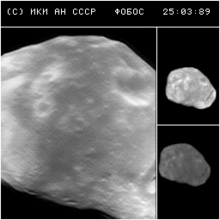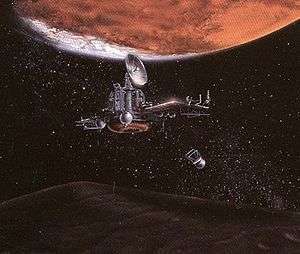Phobos 2
|
Illustration of the Phobos spacecraft | |
| Mission type | Orbiter |
|---|---|
| Operator | IKI |
| COSPAR ID | 1988-059A |
| SATCAT № | 19287 |
| Website | Phobos Mission |
| Spacecraft properties | |
| Launch mass | 2600 kg (6220 kg with orbital insertion hardware attached)[1] |
| Start of mission | |
| Launch date | 17:01:43, July 12, 1988 |
| Rocket | Proton-K rocket |
| Orbital parameters | |
| Reference system | Areocentric |
| Mars orbiter | |
| Orbital insertion | January 29, 1989 |
Phobos 2 was a Russian space probe designed to explore Mars's moons Phobos and Deimos. It was launched on July 12, 1988, and entered orbit on January 29, 1989.

Phobos 2 operated nominally throughout its cruise and Mars orbital insertion phases on January 29, 1989, gathering data on the Sun, interplanetary medium, Mars, and Phobos. Phobos 2 investigated Mars surface and atmosphere and returned 37 images of Phobos[2] with a resolution of up to 40 meters.
Shortly before the final phase of the mission, during which the spacecraft was to approach within 50 m of Phobos' surface and release two landers, one a mobile "hopper", the other a stationary platform, contact with Phobos 2 was lost. The mission ended when the spacecraft signal failed to be successfully reacquired on March 27, 1989. The cause of the failure was determined to be a malfunction of the on-board computer.[2]
Instruments
The Phobos 2 infrared spectrometer (ISM) obtained 45000 spectra in the near infrared (from 0.75 to 3.2 µm) in the equatorial areas of Mars, with a spatial resolution ranging from 7 to 25 km, and 400 spectra of Phobos at 700 m resolution. These observations made it possible to retrieve the first mineralogical maps of the planet and its satellite, and to study the atmosphere of Mars. ISM was developed at IAS and DESPA (Paris Observatory) with support from CNES.
List of instruments:
- "VSK" TV imaging system
- PROP-F "hopping" lander.
- ARS-FP automatic X-ray fluorescence spectrometer
- ferroprobe magnetometer
- Kappameter magnetic permeability / susceptibility sensor
- gravimeter
- temperature sensors
- BISIN conductometer / tiltmeter
- mechanical sensors (penetrometer, UIU accelerometer, sensors on hopping mechanism)
- "DAS" (long-lived autonomous station) lander
- TV camera
- ALPHA-X Alpha-Proton-X-Ray Spectrometer
- LIBRATION sun sensor (also known as STENOPEE)
- Seismometer
- RAZREZ anchor penetrometer
- Celestial mechanics experiment
- "ISM" thermal infrared spectrometer/radiometer - 1–2 km resolution
- near-infrared imaging spectrometer
- thermal imaging camera; magnetometers
- gamma-ray spectrometers
- X-ray telescope
- radiation detectors
- radar and laser altimeters
- Lima-D laser experiment - designed to vaporise material from the Phobos surface for chemical analysis by a mass spectrometer
Legacy
The Phobos design was used again for the long delayed Mars 96 mission which ended in failure when the launch vehicle's fourth stage misfired. In addition, the Fobos-Grunt mission, also designed to explore Phobos, ended in failure in 2011. Thus far, there has not been a truly successful probe to Phobos.
References
External links
- High quality processed images from the Phobos 2 mission
- Phobos mission images from the Space Research Institute (IKI)
- Raw image data from the Phobos 2 ISM infrared instrument
- What we are searching for on Phobos - an article on the Phobos program at the Web site of the Russian Space Agency (Russian)
- Another site with processed images from the Soviet Phobos 2 mission




.jpg)
.jpg)